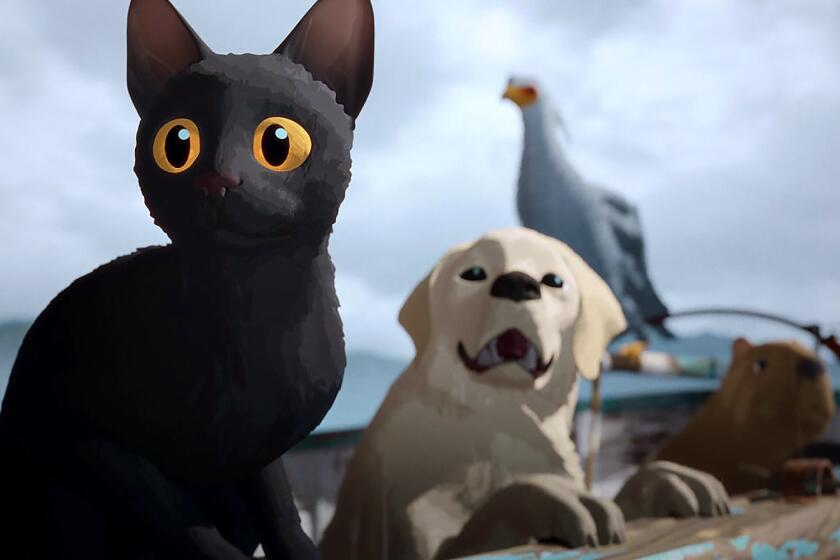A history lesson in ‘Chicago 10’
What constitutes a documentary and what doesn’t is a subject that’s been hotly debated in the last decade or so. Whatever the merits of each side of the argument, it’s undeniable that the genre has changed radically, with the most interesting docs filling the gap in the public discourse between straight news and opinion. Are they tendentious? Absolutely. But they back up their arguments with eloquent images. Their mission is to contextualize, make connections, draw conclusions and, ideally, spur action.
Brett Morgen’s unapologetic “Chicago 10” is a sterling example of this kind of filmmaking. The film is a reconstruction of the events surrounding the 1968 Democratic convention in Chicago -- from the Yippie festival in Lincoln Park to the police riots that followed -- and the conspiracy trial, a year later, of the activists and protesters known as the Chicago 7 (originally the Chicago 8: Abbie Hoffman, Jerry Rubin, David Dellinger, Tom Hayden, Rennie Davis, John Froines, Lee Weiner and Bobby Seale).
Morgen weaves the two components of the narrative together from archival footage and animated segments voiced by actors (the trial sequences were adapted from court transcripts) and underscores them with ‘60s protest music and more recent tracks.
Morgen, whose previous film, the Robert Evans documentary “The Kid Stays in the Picture” was put together in a similar way, draws comparisons between the political situation of the late 1960s and the situation today. Or rather he hammers home the contrasts until it becomes impossible to watch the film and not wonder why another escalating, pointless war has yet to spark anything remotely resembling the social activism of that era.
OK, maybe we know. Rubin became a dedicated Yuppie who touted wealth-creation as the ultimate form of activism. But in Morgen’s considered view, what happened later is not the point. “Chicago 10” wants to re-celebritize counterculture figures like Hoffman and Rubin, to remind us that they were rock stars in their day.
The movie begins in early 1968, with President Lyndon B. Johnson announcing that the monthly draft call would increase from about 17,000 troops per month to 35,000, and activists from the National Mobilization Committee to End the War in Vietnam (MOBE), Students for a Democratic Society (S.D.S.) and the Yippies meeting to make plans for protesting during the convention in Chicago. Protesters were denied permits for anti-war demonstrations and clashed with police in the streets several times in the week leading up to the convention. The violence culminated in a police riot that was televised and watched by 50 million viewers.
The trial that followed tried to locate fault in the instigation of the riots. The government brought Hoffman, Rubin, Dellinger, Hayden, Davis, Froines and Weiner to trial along with Seale, the co-chair of the Black Panther Party, who during a two-day stay in the city had encouraged demonstrators to fight back against police assaults. Because Seale’s attorney was recovering from surgery, Seale demanded to represent himself. The judge, Julius Hoffman, denied his request, Seale became belligerent, and Hoffman had him gagged and bound to a chair.
The other defendants were represented by William Kunstler and Leonard Weinglass, whom the judge eventually found in contempt and sentenced to prison terms -- hence the Chicago “10.”
All of this is shown in an animated sequence done with motion-capture technology. The result is effective, though disconcerting, as the film cuts back and forth from footage of the actual Hoffman and a digital Hoffman, voiced by Hank Azaria, looking oddly robotic in a box-like courtroom. (Other actors who lent their voices to the principal characters include Dylan Baker, Nick Nolte, Mark Ruffalo, the late Roy Scheider, Liev Schreiber and Jeffrey Wright.) It has the effect of making the trial portion of the film seem surreal.
Morgen’s decision to avoid talking heads recounting events and find a way to dramatize them instead is consistent with his intention for the film. The director wants to bring recent history to life for people who weren’t around to witness it, and in that he succeeds pretty admirably.
--
--
MPAA Rating: R for language and brief sexual images. Run time: One hour, 43 minutes. At the Nuart, 11272 Santa Monica Blvd., West Los Angeles (310) 281-8223; Edwards University Town Center, 4245 Campus Drive, Irvine (949) 854-8818
More to Read
Only good movies
Get the Indie Focus newsletter, Mark Olsen's weekly guide to the world of cinema.
You may occasionally receive promotional content from the Los Angeles Times.










